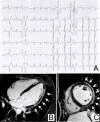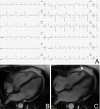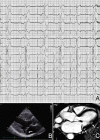How to evaluate premature ventricular beats in the athlete: critical review and proposal of a diagnostic algorithm
- PMID: 31481389
- PMCID: PMC7513269
- DOI: 10.1136/bjsports-2018-100529
How to evaluate premature ventricular beats in the athlete: critical review and proposal of a diagnostic algorithm
Abstract
Although premature ventricular beats (PVBs) in young people and athletes are usually benign, they may rarely mark underlying heart disease and risk of sudden cardiac death during sport. This review addresses the prevalence, clinical meaning and diagnostic/prognostic assessment of PVBs in the athlete. The article focuses on the characteristics of PVBs, such as the morphological pattern of the ectopic QRS and the response to exercise, which accurately stratify risk. We propose an algorithm to help the sport and exercise physician manage the athlete with PVBs. We also address (1) which athletes need more indepth investigation, including cardiac MRI to exclude an underlying pathological myocardial substrate, and (2) which athletes can remain eligible to competitive sports and who needs to be excluded.
Keywords: arrhythmias; athlete’s heart; disqualification; ectopic beats; eligibility; premature ventricular contraction; sudden cardiac death.
© Author(s) (or their employer(s)) 2020. Re-use permitted under CC BY-NC. No commercial re-use. See rights and permissions. Published by BMJ.
Conflict of interest statement
Competing interests: None declared.
Figures






References
-
- Mont L, Pelliccia A, Sharma S, et al. . Pre-participation cardiovascular evaluation for athletic participants to prevent sudden death: position paper from the EHRA and the EACPR, branches of the ESC. endorsed by APHRS, Hrs, and SOLAECE. Eur J Prev Cardiol 2017;24:41–69. 10.1177/2047487316676042 - DOI - PubMed
-
- Heidbüchel H, Corrado D, Biffi A, et al. . Recommendations for participation in leisure-time physical activity and competitive sports of patients with arrhythmias and potentially arrhythmogenic conditions. Part II: ventricular arrhythmias, channelopathies and implantable defibrillators. Eur J Cardiovasc Prev Rehabil 2006;13:676–86. 10.1097/01.hjr.0000239465.26132.29 - DOI - PubMed
-
- Zipes DP, Link MS, Ackerman MJ, et al. . Eligibility and Disqualification recommendations for competitive athletes with cardiovascular abnormalities: Task force 9: arrhythmias and conduction defects: a scientific statement from the American heart association and American College of cardiology. Circulation 2015;132:e315–25. 10.1161/CIR.0000000000000245 - DOI - PubMed
Publication types
MeSH terms
LinkOut - more resources
Full Text Sources
